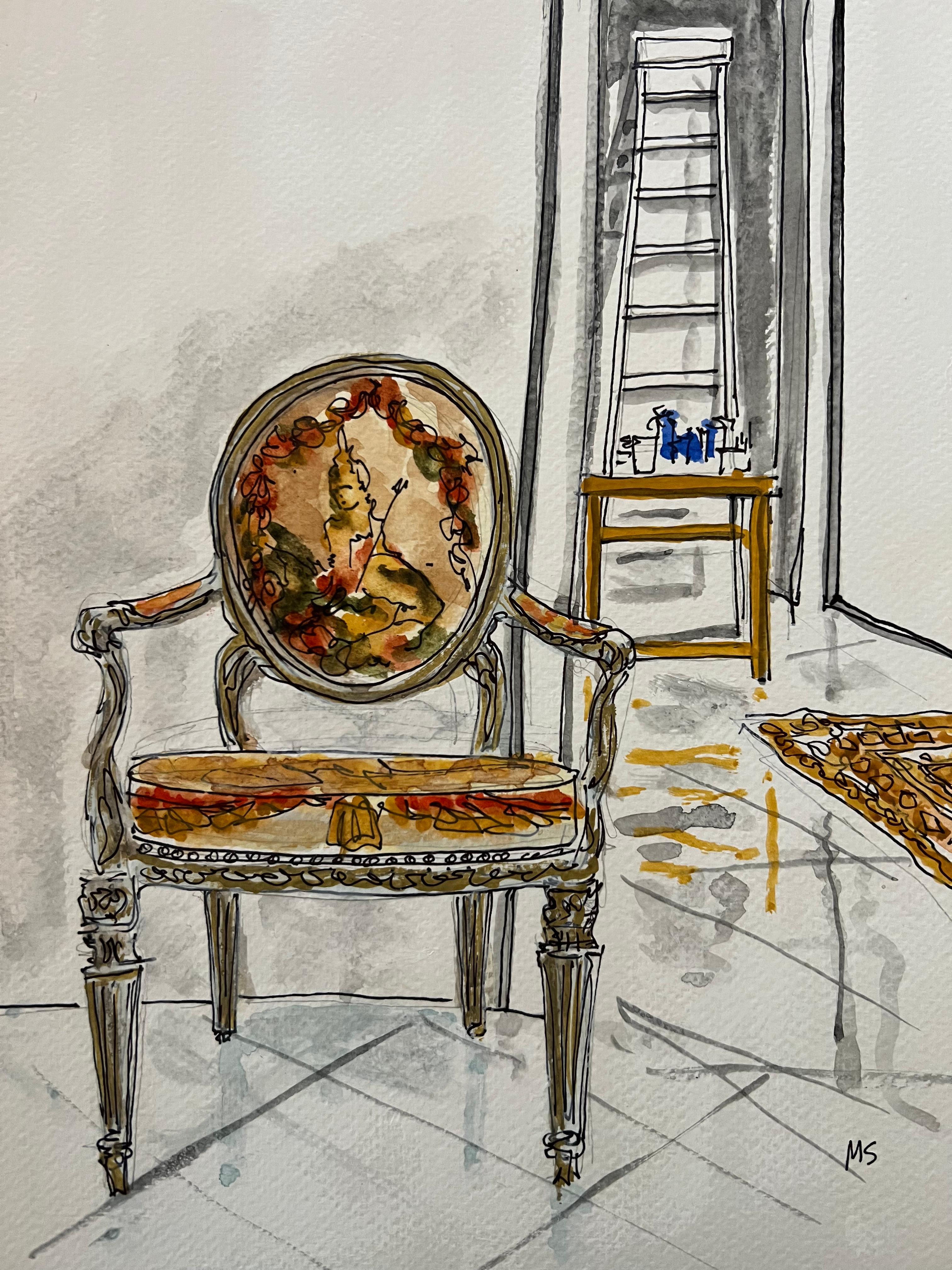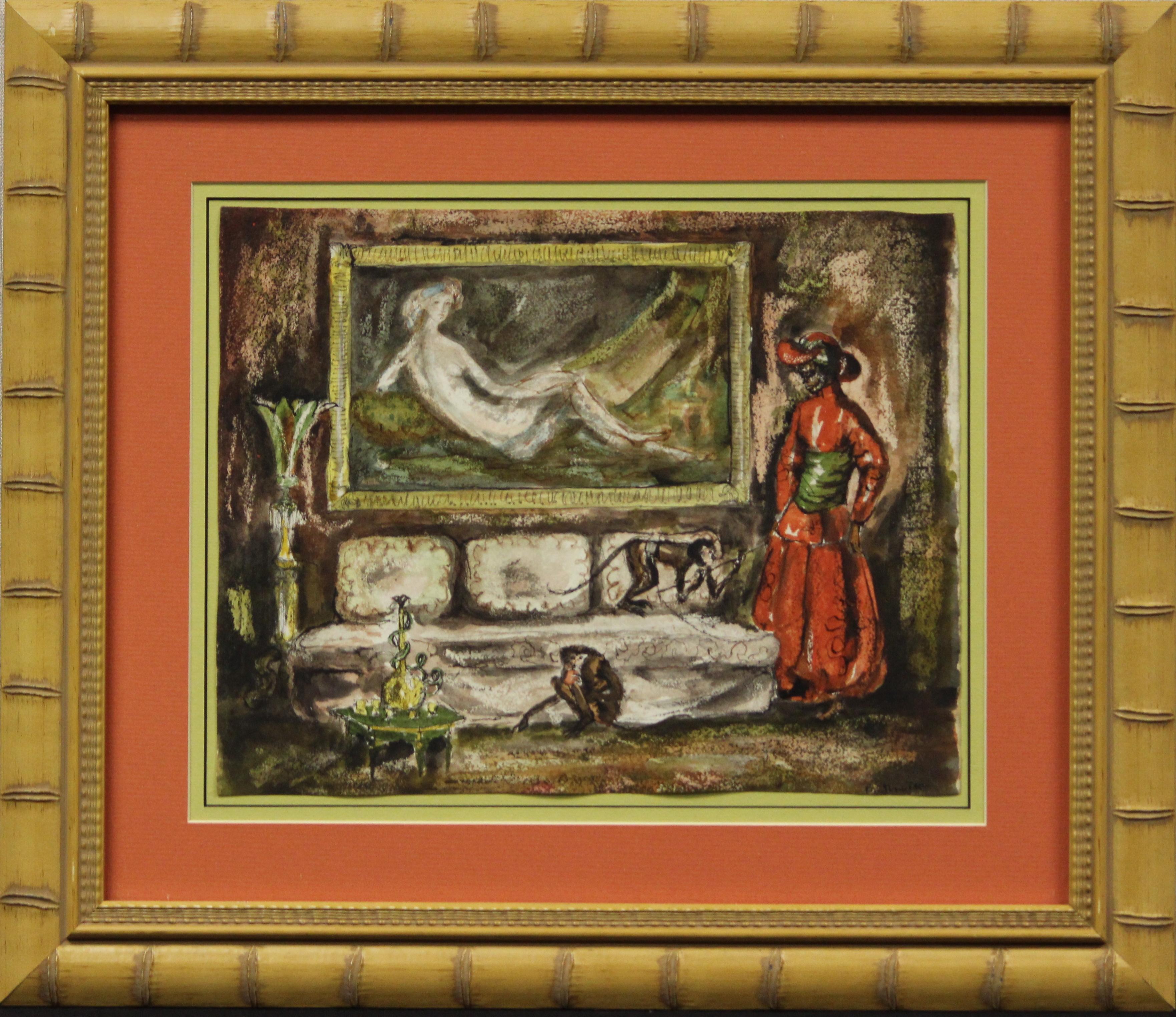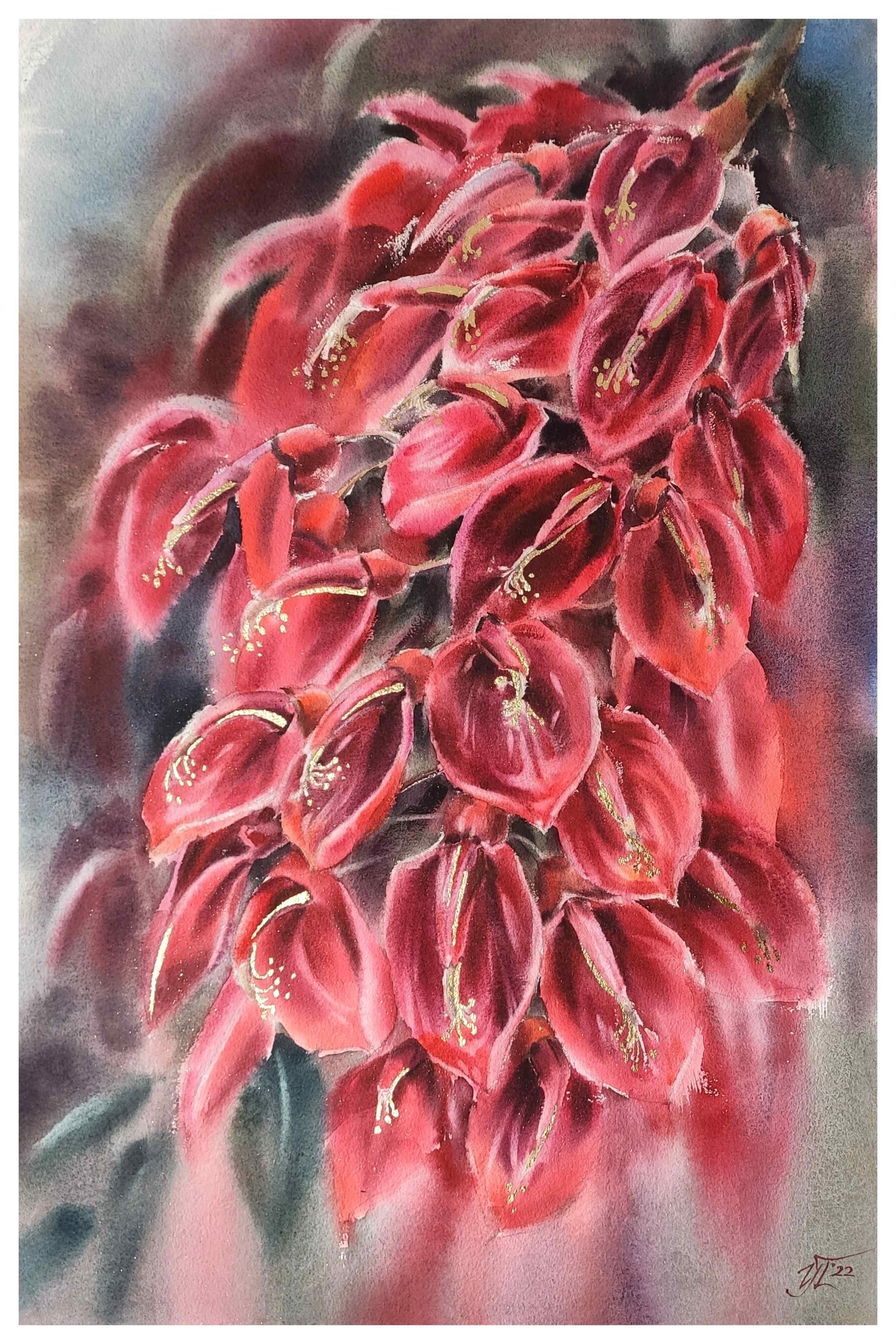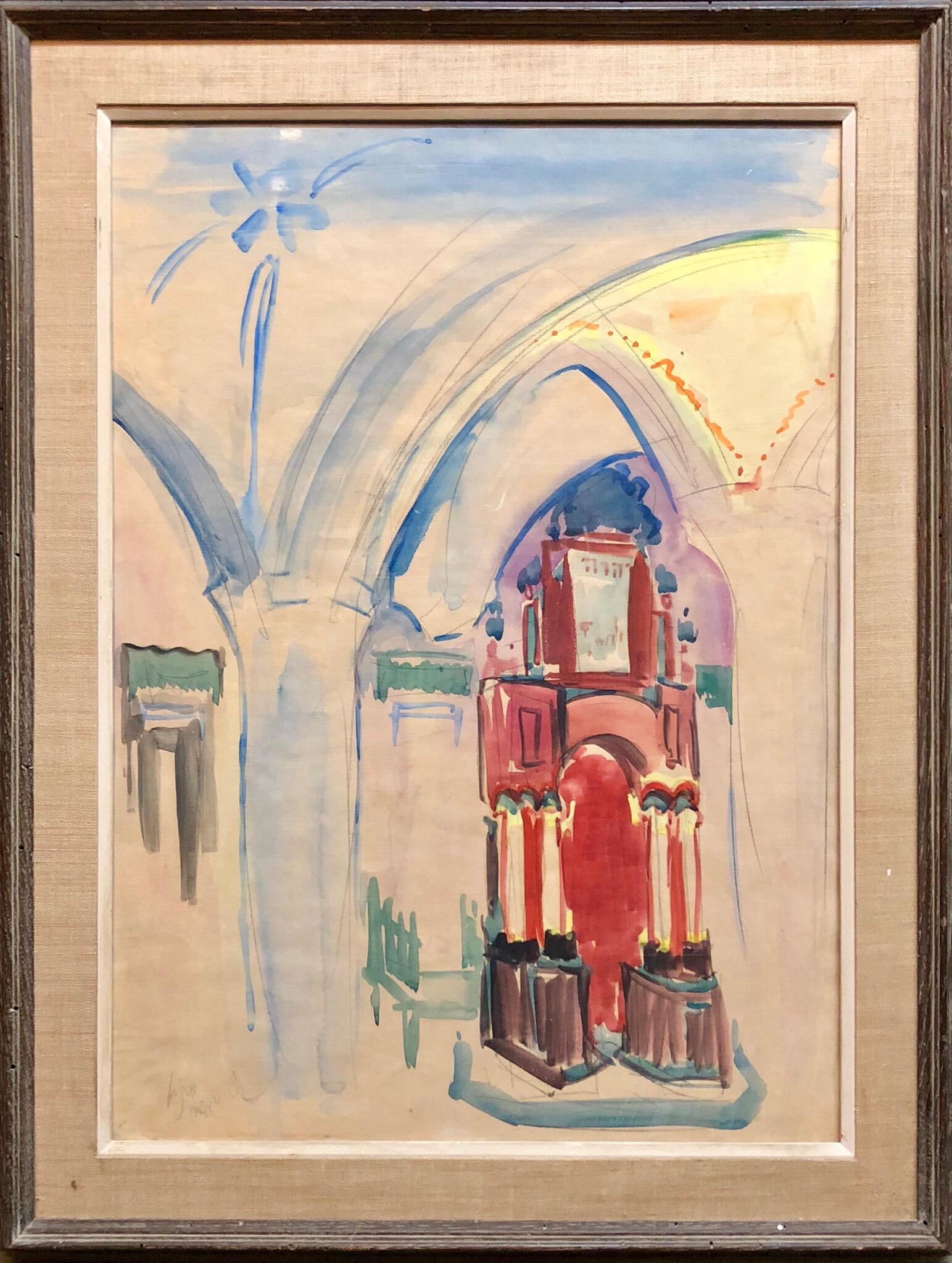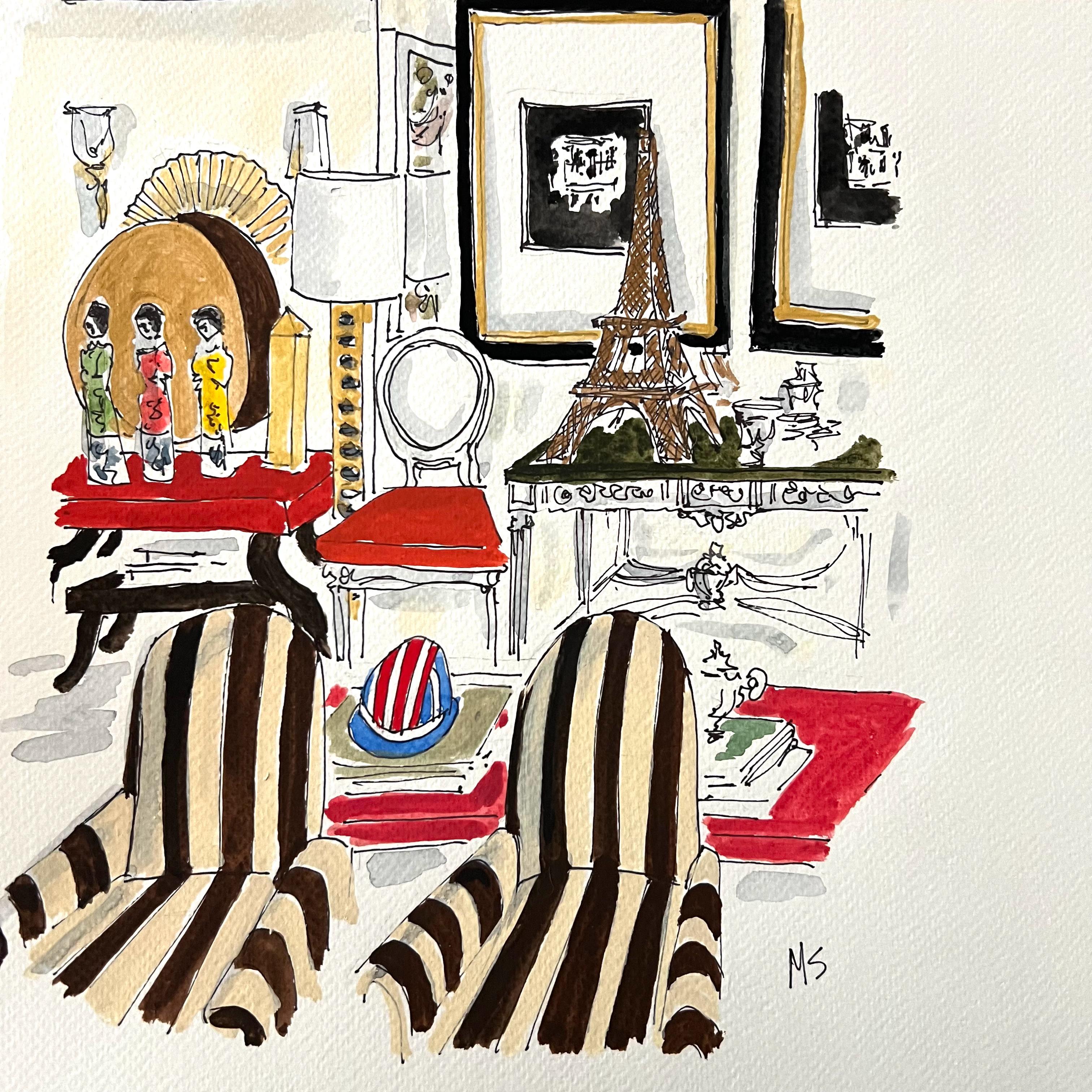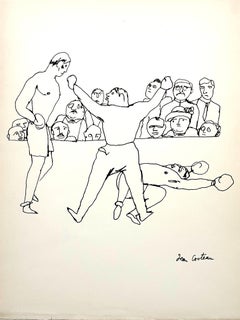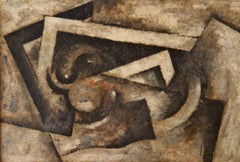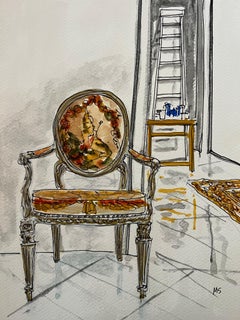After Pablo Picasso - Interior - Gouache with Stencil
View Similar Items
Pablo PicassoAfter Pablo Picasso - Interior - Gouache with Stencil 1933
1933
About the Item
- Creator:Pablo Picasso (1881-1973, Spanish)
- Creation Year:1933
- Dimensions:Height: 15.75 in (40 cm)Width: 20.48 in (52 cm)Depth: 0.4 in (1 cm)
- Medium:
- Movement & Style:
- Period:
- Condition:
- Gallery Location:Collonge Bellerive, Geneve, CH
- Reference Number:1stDibs: LU16121800223
Pablo Picasso
One of the most prolific and revolutionary artists the world has ever seen, Pablo Picasso had a tremendous impact on the development of 20th-century modern art. Although he is best known for his association with the Cubist movement, which he founded with Georges Braque, Picasso’s influence extends to Surrealism, neoclassicism and Expressionism.
“Every act of creation is, first of all, an act of destruction,” the Spanish artist proclaimed. In Picasso's Cubist paintings, he emphasizes the two-dimensionality of the canvas, breaking with conventions regarding perspective, foreshortening and proportion. Picasso was inspired by Iberian and African tribal art. One of his most famous pre-Cubist works is Les Demoiselles d’Avignon (1907), a painting considered immoral and shocking at the time for its depiction of nude women whose faces resemble Iberian tribal masks.
Picasso made many portraits in this style, most often of the women in his life, their expressively colored faces composed of geometric shards of surface planes. In Woman in a Hat (Olga), 1935, he painted his first wife as an assemblage of abstract forms, leaving the viewer to decipher the subject through the contrasting colors and shapes. Picasso was a tireless artist, creating more than 20,000 paintings, drawings, prints, ceramics and sculptures. Tracing his life’s work reveals the progression of modern art, on which he had an unparalleled influence.
Browse an expansive collection of Pablo Picasso's art on 1stDibs.
- Jean Cocteau - The Fight - Original Signed DrawingBy Jean CocteauLocated in Collonge Bellerive, Geneve, CHJean Cocteau - The Fight - Original Signed Drawing 1923 28 x 22 cm Signed This drawing was made as a frontispiece of the book Dessins publishe...Category
1920s Modern Figurative Drawings and Watercolors
MaterialsPen
- Ferjo - Surrealist Interior - Signed Oil on CanvasBy FerjoLocated in Collonge Bellerive, Geneve, CHFERJO Intérieur surréaliste Signed Oil on Canvas 51 x 61 cm Ferjo, Brazilian (1946 - ) Ferjo Technical achievements in art not only in painting...Category
1990s Surrealist Interior Paintings
MaterialsOil
- Robert Marc - Untitled - Signed Oil on CanvasBy Robert MarcLocated in Collonge Bellerive, Geneve, CHRobert Marc Untitled Oil on Canvas Signed 60 x 80 cm 80 x 100 cm (Framed) The painting is rich and complex with a palette and surface quality that warms and harmonises his ge...Category
1950s Cubist Abstract Paintings
MaterialsOil
- Louis Toffoli - BrodeuseBy Louis ToffoliLocated in Collonge Bellerive, Geneve, CHLouis TOFFOLI (1928 - 1999) Brodeuse Signed lower right Oil on canvas 55 x 38,1 cm 78 x 60 cm (Framed) Louis TOFFOLI was born in Trieste, in Italy in 1907. After graduatin...Category
1970s Cubist Figurative Paintings
MaterialsOil
- Jean Cocteau - Europe's Agriculture - Original LithographBy Jean CocteauLocated in Collonge Bellerive, Geneve, CHOriginal Lithograph by Jean Cocteau Title: Europe's Agriculture Signed in the stone/printed signature Dimensions: 33 x 46 cm Luxury impression from the portfolio published by Sciaky....Category
1960s Cubist Animal Prints
MaterialsLithograph
- After Georges Braque - Antiborée - LithographLocated in Collonge Bellerive, Geneve, CHLithograph after Georges Braque. Signed in the plate Edition of 150 Dimensions: 76 x 117 cm Bibliography: « Les Métamorphoses de Braque» of Heger de Loewenfeld and Raphaël de Cuttoli , Editions FAC, Paris, 1989. In 1961 Georges Braque decided with his laidary friend Heger de Loewenfeld to pick up certain of his works to in order to create artworks, this beautiful litograph is one of them. Héméra in the Mythology: In Greek mythology Hemera was the personification of day and one of the Greek primordial deities. She is the goddess of the daytime and, according to Hesiod, the daughter of Erebus and Nyx (the goddess of night). Hemera is remarked upon in Cicero's De Natura Deorum, where it is logically determined that Dies (Hemera) must be a god, if Uranus is a god. The poet Bacchylides states that Nyx and Chronos are the parents, but Hyginus in his preface to the Fabulae mentions Chaos as the mother/father and Nyx as her sister. She was the female counterpart of her brother and consort, Aether (Light), but neither of them figured actively in myth or cult. Hyginus lists their children as Uranus, Gaia, and Thalassa (the primordial sea goddess), while Hesiod only lists Thalassa as their child. The father of Cubism Three Cubist that distinguishes art historian periods were initiated and developed by Georges Braque: The Cubist Cézanne (1907-1909), Executive (1909-1912) and synthetic (1912-1922). Post-Impressionist and fawn, Braque no longer adheres to the contingency of a decorative way or the other. Cézanne’s paintings exhibited at the Grand Palais during the retrospective of 1907 are a revelation: Cézanne sought and invented a pictorial language. In his footsteps, Braque went to the South with the reasons of the Master. He returned with Estaque landscapes and surprising Ciotat it keeps Cezanne geometric model and retains the “passages” continuity from one surface to another to create the sensation of “turning around” of the object represented. But he wants to go after the consequences of the vision of Cezanne. In his paintings Houses in L’Estaque (1908) it simplifies the volumes of houses, neglects detail by removing doors and windows: the plastic rhythm that builds the table. Large Nude , a masterpiece of the period, can be considered the first work of Cézanne cubism . Systematizing and deepening Braque discoveries open the door analytical cubism. In 1909, his painting became more cerebral than sensual. The pattern is recreated in the two-dimensionality of the canvas, leaving aside any illusionistic perspective. In Still Life with Violin, objects are analyzed facets according to their characteristic elements, each facet referring to a particular view of the object. There are so many facets of points selected view: Table reflects the knowledge of the object and the ubiquity of the eye. Moreover, Braque is looking for the essence of the objects in the world rather than their contingency, which explains the absence of light source and use of muted colors (gray, ocher), contingent aspects of the object . But formal logic has stepped facets, erased any anecdote to the object and ultimately led to his painting a hermetic more marked on the edge of abstraction (see the series of Castle Roche-Guyon ). Braque, anxious to keep the concrete and refusing at all costs that the logic of Cubism takes the paintings to abstract, reintroduced signs of reality in his paintings in 1912 marks the beginning of Synthetic Cubism. Historians speak of “signs of real” rather than reality because what interests Braque, this is not to put reality into a table, but to create a painting which, by its language, refers to the real. To do this, he invented two major techniques XX th century inclusions and contributions. The inclusions consist of painting objects that have no real depth, materials (wallpaper in Nature morte aux playing cards faux wood is a pictorial inclusion) or letters (calligraphic inclusion in Portuguese ), made first brush and a few months later stencil. Contributions are defined in contrast with the collage on canvas of foreign materials: glued or sand paper, sawdust, etc.. Regarding the collages, Braque used for the first time in September 1912 a piece of adhesive paper imitating faux wood Compote...Category
1950s Cubist Animal Prints
MaterialsLithograph
- "Interior with sculpture" cm. 25 x 44 1954By Giulio da MilanoLocated in Torino, ITInterior with African statue, cubist guitar,Gray, black, taupe Giulio DA MILANO (Nizza, 1895 - Torino, 1990) Giulio Da Milano was a Giacomo Grosso's di...Category
1950s Cubist Interior Paintings
MaterialsWatercolor
$2,714 Sale Price35% OffFree Shipping - Cy Twombly’s chair. Interiors Watercolor PaintingBy Manuel SantelicesLocated in Miami Beach, FLCy Twombly’s chair by Manuel Santelices Ink, gouache, and watercolor on paper Image size: 12" H x 9" W inches. Unframed 2023 Manuel Santelices explores the world of fashion, soci...Category
21st Century and Contemporary Contemporary Interior Drawings and Waterco...
MaterialsGouache, Watercolor, Ink, Paper
- A Room by the Belgian visual artist and antque dealer Axel VervoortBy Manuel SantelicesLocated in Miami Beach, FLA Room by Axel Vervoort, by Manuel Santelices Ink pen, gouache, and watercolor on paper Image size: 6 in. H x 8 in. W One of a Kind Unframed 2021 The w...Category
21st Century and Contemporary Contemporary Interior Drawings and Waterco...
MaterialsInk, Paper, Watercolor, Gouache, Pen
- "Orientalist Interior" Watercolor by Philippe Jullian Ex- D.D. Ryan EstateBy Philippe JullianLocated in Bristol, CTElegant & fabulously rare, original Philippe Jullian (1919-1977) (ink signed LR) watercolour depicting a lavish Moorish opium salon interior with a reclining nude portrait on the wall and two monkeys with their turban clad handler. Sagittarius Gallery, NY label inscribed Jullian No. 18 on verso Art Sz: 8 3/4"H x 11 1/8"W Frame Sz: 16"H x 18"W w/ Hermes orange mat & antique bamboo frame Provenance: The estate of D. D. Ryan (1928-2007), noted fashion editor at Harper's Bazaar, an associate of Halston and a regular on best-dressed lists! Another widely appreciated achievement is her association with the creation of Eloise, the fictional little girl who lives at the Plaza Hotel. Eloise began as a character that Kay Thompson, a cabaret singer, portrayed to amuse her friends, of whom Ms. Ryan was one. Ms. Ryan urged her to write a book, put her together with Hilary Knight, the illustrator, and never stopped pushing her to finish the job. The result was “Eloise,” published in 1955 and a best seller the next year, and its popular sequels. “The book would never have existed without D. D. Never,” Mr. Knight said in an interview Thursday. “She would have just dropped it and gone on to something else.” Beyond her historic Eloise moment, Ms. Ryan thrived at the crossroads of New York’s fashion and artistic worlds, seeming to make a statement every time she dressed, almost always in clothes she made herself, always recognizable with her famous precisely stylized eyebrows. Her first job in Manhattan was as an assistant to the photographer Richard Avedon; she was photo editor at Harper’s Bazaar under the legendary editor Diana Vreeland, and she designed the costumes for Stephen Sondheim’s 1970 Broadway musical “Company.” Her social circle included Cole Porter, Andy Warhol, Mr. Sondheim and Truman Capote. When she recommended a new pair of sandals or a piece of costume jewelry — only “really good costume jewelry...Category
20th Century Other Art Style Interior Drawings and Watercolors
MaterialsWatercolor
- Rose bouquet Watercolor Roses AquarelleLocated in Zofingen, AGBeautiful painting for the living room. Watercolor painting in soft colors for the bedroom. Painting with roses for the bedroom interior. Interior painting with roses. Delicate watercolor in pure coral shades with garden roses. Rose is truly the queen of flowers. It has tenderness, versatility and beauty of the inflorescence. And how it smells! Watercolor painting with roses is always a pleasure to look at, admiring the tenderness and sophistication of the shades. This floral painting was created based on the impression of a walk through my mother's rose garden. The painting with roses will fit perfectly into both modern and classic interiors. Watercolor painting is a wonderful gift for a celebration or anniversary. Size: 38x56cm Author: Irina Pronina...Category
2010s Impressionist Interior Drawings and Watercolors
MaterialsWatercolor, Paper
- Royal orchid Floral watercolor painting for living roomLocated in Zofingen, AGThe painting for interior Royal Orchid is a delicate, refined watercolor made on cotton paper with multifaceted granulating shades. Beautiful orchid flowers on a platter surrounded b...Category
2010s Impressionist Interior Paintings
MaterialsPaper, Watercolor
Recently Viewed
View AllRead More
Science Uncovers Hidden Truths behind Young Pablo Picasso’s Blue Period
From 1901 to 1904, Picasso limited his palette to bluish hues in producing some of his most famous early works. A new show looks at the recycled materials, hidden underpaintings, surprising influences and bohemian lifestyle that led to their creation.
Who Are the Most Popular Artists on 1stdibs?
Learn the stories of some of the world's most recognizable artworks and their makers.

